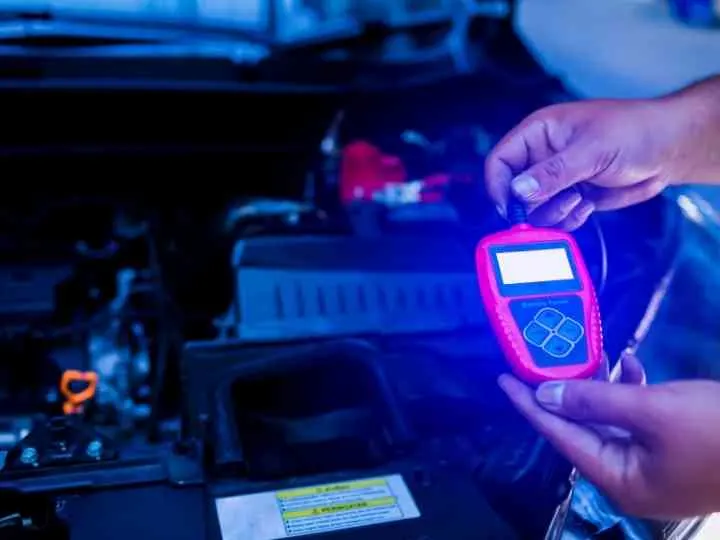Voltmeters and multimeters let you test the health of your car’s battery. However, they’re not always 100% accurate.
They’ll give you an accurate measurement of the battery’s voltage, most of the time.
Most digital battery testers are largely accurate with an expected accuracy of plus or minus 0.5% when testing a car battery. By comparison, analog battery testers have an accuracy range of plus or minus 3%.
A battery can have plenty of volts and still not work, though. If it has too much internal resistance, it won’t be able to crank the car.
How Accurate Are Car Battery Testers?
Measuring the accuracy of a battery tester isn’t always easy. Most of them display results using a relative measurement, instead of absolute.
That means it can tell you the difference in electrical potential between objects.
However, they’re not always able to measure the electrical potential of an object. High-quality battery testers are usually more accurate than cheaper models.
We can also describe battery testers by looking at their resolution. Some of them are able to measure small units of electrical potential, like 1 mV.
Not all of them have the ability to measure units that small, though.
A lot of digital multimeters have settings where you can adjust their resolution. So, you can set them to measure small units if you’d like them to.
You’ll get better results if you’re using a digital multimeter. They’ve designed them to be more accurate than their analog counterparts.
n analog multimeter has an accuracy rate of +/- 3%.
So, you can expect an analog multimeter to give you something within 3% of the actual result.
Most digital ones can give you a result that’s within 0.5% of the actual result, though.
Can Battery Testers Be Wrong?
The accuracy of your battery tester’s measurements depends on what you’re measuring. If you’re measuring something that’s high-voltage, it’ll be less accurate.
The more power you’re measuring, the less accurate it’ll be.
Another factor that can impact your equipment’s accuracy is how long it’s been used.
Using a battery tester tends to make it drift out of calibration over time. You may need to recalibrate your device if you’ve used it a lot.
You may not be testing the battery properly, either. You’ve got to test them properly if you’d like to get accurate results.
If you’re using a digital multimeter, it’s not hard. Set it to DCV. This setting lets you measure a circuit’s voltage.
Take the multimeter’s positive probe and touch the battery’s positive terminal. Touch the negative terminal with the negative probe while holding the other one in place.
After you’ve touched both probes to the battery, your multimeter should light up. You should see a reading on its screen that tells you how many volts the battery is making.
A good battery should produce more than 12 volts. Many of them produce over 14 volts whenever they’re fully charged.
If it’s not making that many, it’s not going to work. Less than 12 volts isn’t enough to crank the engine on most cars, nowadays.
You can also try to test the battery’s amps by using the appropriate setting on the multimeter. However, that’s not always going to tell you whether your car will work.
Testing its amps can tell how much charge the battery has after you’ve disconnected it from a charger.
Most batteries have a label on them that tells you how many cold-cranking amps they have.
You should be able to test the battery’s amps and compare its results to what’s on the label. It should produce however many amps it has on the label after it’s finished charging.
Using the proper technique should minimize most inaccuracies. But, you should always use high-quality equipment to conduct your tests. They’ll give you more accurate results than using something that’s cheap.
Make sure to set your multimeter to the appropriate setting if you’re testing the battery, too.
Trying to measure a battery’s potential in KV wouldn’t be useful. Always use millivolts when you’re testing one of them to get the most accurate results.

Can a Car Battery Test Good but Still Be Bad?
If you’ve tested a battery’s voltage, but it’s still not working, resistance may be a problem. A battery can have enough volts to crank a car and still have issues doing it.
When you’ve used a battery for a while, resistance begins building within its cells. All batteries have a limited number of charges, called their cycle life.
You can only use them so much before they’re no longer able to hold a charge.
Testing the battery’s voltage could give you a reading that’s above 12 volts.
But, you might not be able to crank the car if you’ve got it in the engine bay. That’s because the battery’s circuits have too much resistance in them.
You can actually test the battery’s resistance by using a multimeter. Set yours to the resistance setting and use it to check the battery. The more ohms it has, the more resistance there is.

When to Replace A Car Battery
Replacing your car’s battery is often the only way you’re able to get it back on the road. All batteries die at some point.
So, getting a replacement isn’t something you can avoid. Here are a few signs that it’s time for one.
You can tell that it’s time for a replacement by timing your battery while it’s on a charger. It should take several hours for it to reach full capacity if it’s been fully discharged.
If the battery charges up all the way in a few minutes, it’s dead.
The charger says that it’s at full capacity, but it’s not. The battery isn’t able to hold much charge anymore, so it doesn’t take long to charge it.
Another way you can check is by asking when was the last time you got a replacement.
If you’ve had your battery for a couple of years, it’s probably time for a new one.
Most batteries last for up to 3 years. Longer than that would be more than expected.
You can also use your multimeter to test the battery’s voltage whenever it’s under a load.
Turn on the car and use it to check the battery’s voltage. You should notice an increase compared to when the car is off.
It should read above 12 volts once you’ve turned on the engine. A brand-new battery is going to produce over 14 volts when the engine is running. If you’re not producing that much, it’s time to get a new one.
Testing your battery’s voltage while the car is running shows you how it handles being put under a load.
Putting it under a load usually makes them produce more electrical output. But, that’s not the case once they’ve gotten too old.

Dave
Thursday 3rd of August 2023
If you set your multimeter to resistance and try and test your battery your will blow the fuse in your meter if you are lucky or destroy the multimeter if unlucky. You don't test resistance on a live circuit.